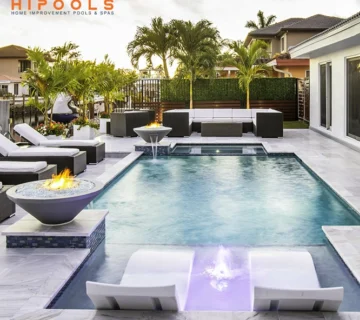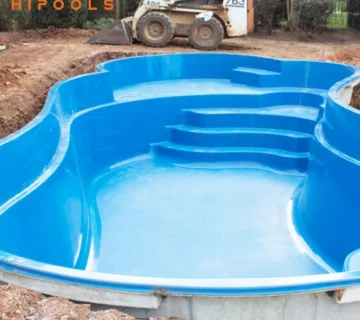A sloped backyard might seem challenging for pool installation, but it’s a golden opportunity to create a stunning, multi-level oasis. From infinity edges that blend with horizons to tiered designs with cascading waterfalls, slopes offer unique advantages for innovative poolscapes.
This Blog covers how to build a pool installation on a sloped backyard, including design ideas, engineering solutions, and cost-saving strategies to transform your hill into a highlight.
Assessing Your Sloped Backyard: Laying the Groundwork for Success
Building a pool on a sloped backyard begins with a thorough assessment of your site’s unique terrain. Skipping this step risks costly setbacks, from soil instability to drainage disasters. Here’s how to evaluate your slope and soil to ensure a safe, sustainable installation.
Understanding Slope Gradient
The steepness of your slope dictates construction complexity and cost. Measure the gradient by calculating the vertical rise over horizontal run (…, a 10 foot rise over a 100 foot run = 10% slope).
Gentle Slopes (5,10%)
- Characteristics: Slight inclines that blend naturally into the landscape.
- Solutions: Minor retaining walls (3,4 feet tall) or terracing with railroad ties or concrete blocks.
- Example: A 7% slope in a Texas backyard required a 3 foot stone retaining wall to level the pool area, costing $8,000.
Click here for 40 Stunning Ways to Landscape Around a Swimming Pool.
Steep Slopes (15%+)
- Challenges: High erosion risk, unstable soil, and complex access for machinery.
- Solutions: 1.Structural Engineering: Steel reinforced concrete footers or pilings drilled into bedrock. 2. Terracing: Multi level platforms with tiered retaining walls. 3. Gabion Baskets: Wire cages filled with rocks to stabilize soil ($30, $50/sq. ft).
- Example: A Colorado hillside with a 20% slope needed $25,000 in gabion walls and helical pilings to support a pool.
Soil Type: The Foundation of Your Project
Soil composition impacts excavation, drainage, and structural support.
Clay Soil
- Pros: Holds shape well during excavation.
- Cons: Expands when wet, increasing erosion and pressure on retaining walls.
- Solutions: Use reinforced concrete walls with drainage pipes to redirect water.
Rocky Soil
- Pros: Offers a stable base for pools; less prone to shifting.
- Cons: Hard to excavate, requiring jackhammers or blasting (costs rise by 20_50%).
- Solutions: Opt for fiberglass pools, which fit into pre-dug holes, minimizing excavation.
Note Tip: Hire a geotechnical engineer ($500_$2,000) to analyze soil stability and recommend drainage solutions. Their report can prevent costly surprises, like discovering hidden springs or loose fill.
Design Options for Sloped Backyards: Turning Challenges into Assets
A sloped yard isn’t a limitation it’s an opportunity to innovate. Below, we explore three stunning designs that leverage elevation for dramatic effect.
A. Infinity Edge Pools: Where Water Meets the Horizon
Best For: Slopes with panoramic views (oceans, mountains, or city skylines).
How It Works:
- Water flows over a “vanishing edge” into a catch basin, recirculating via pumps.
- Requires precise engineering to balance water volume and flow rate.
Construction Considerations:
- Hidden Infrastructure: Catch basins and pumps are buried below the pool.
- Materials: Glass tile or dark plaster amplifies the mirror like effect.
Cost: $70,000–$150,000+ (higher for custom designs or remote locations).
Case Study: A Malibu homeowner spent $140,000 on an infinity pool that appears to merge with the Pacific Ocean, boosting their property value by 18%.
B. Tiered Pool Designs: Multi Level Luxury
Concept: Create distinct zones upper pool, lower spa, or connecting waterfalls to maximize vertical space.
Materials:
- Retaining Walls: Natural stone ($50_$100/sq. ft) for rustic charm or poured concrete ($30_$60/sq. ft) for modern flair.
- Water Features: Cascading waterfalls between tiers enhance ambiance and mask street noise.
Cost: $50,000_$120,000 (varies with materials and height).
Example: A Georgia hillside features a 12×24 ft upper pool flowing into a lower hot tub via a 6 foot stone waterfall ($95,000 total).
C. Raised Deck Pools: Elevate Your Oasis
Solution: Build the pool on the uphill side, using the slope as a natural support wall.
Benefits:
- Space Optimization: The area beneath the deck becomes storage, an outdoor kitchen, or shaded lounge.
- Aesthetic Appeal: Elevated pools create a striking focal point.
Materials:
- Decking: Composite wood ($20_$45/sq. ft) for durability or stamped concrete ($8_$15/sq. ft) for affordability.
- Support: Steel beams or concrete columns anchor the pool into the slope.
Cost: $40,000_$90,000 (excluding under deck amenities).
Case Study: A Seattle homeowner built a raised pool with a built in grill station beneath, transforming a 15% slope into a multi-functional retreat ($82,000).
Key Takeaways
- Gentle Slopes: Ideal for modest retaining walls and budget friendly designs.
- Steep Slopes: Demand engineering expertise but unlock showstopping options like infinity edges.
- Soil Matters: Invest in a geotechnical report to guide material and drainage choices.
By aligning your design with your slope’s natural features, you create a pool that’s both functional and awe-inspiring. Whether you choose the sleek drama of an infinity edge or the rustic charm of tiered stone, your sloped backyard holds endless potential.
Ready to Explore Your Options?
Call Hipools: (770) 250-8579 for a free slope assessment and 3D design render.
Step by Step Construction Process for Sloped Yard Pools
Building a pool on a sloped yard requires meticulous planning and execution to address elevation challenges while ensuring structural integrity. Below is a detailed breakdown of the process, timeline, and key considerations.
1. Excavation: Reshaping the Landscape
The project begins with excavation, where heavy machinery cuts into the slope to create a level base for the pool. This phase involves hauling away excess soil, which can cost between $5,000_$15,000, depending on soil type, accessibility, and slope steepness. Proper excavation is critical to avoid future shifting and to integrate the pool naturally into the terrain.
2. Retaining Walls: Stabilizing the Structure
Next, retaining walls are installed to secure the leveled pool area and prevent landslides. These walls, often built from concrete, stone, or timber, act as barriers against soil erosion and lateral pressure. Engineering these walls requires precise calculations to handle water pressure and soil weight, often adding 10,20% to the total budget.
3. Pool Shell Installation: Choosing Materials
Once the site is stabilized, the pool shell is constructed. Homeowners can opt for poured concrete (durable but time consuming), pre formed fiberglass (quick installation), or vinyl liners (budget friendly). Each material impacts the project’s timeline and cost, with concrete adding 2,4 weeks to the schedule.
4. Drainage Systems: Managing Water Flow
Effective drainage is non negotiable for sloped yards. French drains (perforated pipes surrounded by gravel) or channel systems are installed to redirect groundwater and rainfall away from the pool. Poor drainage risks erosion, foundation cracks, or water damage to adjacent structures.
5. Landscaping: Blending Function and Aesthetics
Finally, landscaping stabilizes the slopes and enhances visual appeal. Terraced gardens, rockscaping, and drought-resistant ground cover reinforce soil retention. Features like stone pathways or retaining wall planters merge practicality with design.
6. Timeline and Challenges
A sloped yard pool typically takes 3,6 months to complete significantly longer than the 2,4 months for flat yards. Delays often stem from weather disruptions, complex engineering for retaining walls, or permit approvals.
Cost Breakdown
| Component | Average Cost |
|---|---|
| Excavation | $5,000_$20,000 |
| Retaining Walls | $5,000_$25,000 |
| Pool Construction | $30,000_$100,000+ |
| Drainage Systems | $2,000_$10,000 |
| Landscaping | $5,000_$15,000 |
| Total | $50,000_$170,000+ |
Budget Tips:
- Opt for gunite pools for custom shapes on uneven terrain.
- Repurpose excavated soil for garden beds or terracing.
Pool Safety for Sloped Yards: Compliance, Tips, and Expert Advice
Building a pool on a sloped yard offers stunning views but demands rigorous safety measures and adherence to regulations. Below, we outline essential safety considerations and answer top FAQs to ensure your project prioritizes security and meets local codes.
Safety Considerations for Sloped Yard Pools
1. Railings for Steep Edges and Staircases
Sloped yards often feature elevation changes, making railings a non-negotiable safety feature. Install sturdy railings along steep drop offs, staircases, or elevated decks to prevent slips and falls. Materials like powder coated steel, tempered glass, or treated wood blend durability with aesthetics. Railings also enhance accessibility for children and elderly users.
2. Non Slip Surfaces
Wet pool areas on slopes are prone to accidents. Opt for textured concrete, composite decking, or natural stone with anti slip coatings around the pool and pathways. These materials provide traction even when wet, reducing injury risks. Avoid smooth tiles or polished surfaces near water zones.
3. Secure Fencing
Most municipalities mandate pool fencing (typically 4,6 feet tall) with self latching gates to prevent unsupervised access. For sloped yards, fencing may need tiered designs to follow the terrain. Ensure gaps between panels are less than 4 inches to meet safety codes.
Can I build a pool on a steep slope without retaining walls?
No. Retaining walls are essential to prevent soil erosion, landslides, and structural damage. Skipping them risks pool collapse, especially during heavy rain. Walls also create usable flat spaces for landscaping or seating.
Are permits harder to secure for sloped backyards?
Yes. Sloped projects face stricter reviews due to erosion and drainage risks. Engineers must submit detailed plans for retaining walls, drainage systems, and soil stability. Permit costs may rise by 15,30% compared to flat yards.
Can I DIY a pool on a slope?
Not advised. Sloped builds require heavy machinery (…, excavators, compactors), geotechnical surveys, and expertise in structural engineering. DIY attempts often lead to costly errors, like improper drainage or wall failures. Always hire licensed contractors.
Why Safety and Compliance Matter
Ignoring safety protocols on sloped yards can lead to:
- Fines for code violations (…, inadequate fencing).
- Insurance issues if injuries occur due to non-compliant design.
- Long term repair costs from erosion or water damage.
Conclusion
A sloped backyard isn’t a obstacle it’s a canvas for creativity. With solutions like infinity edges, tiered designs, and smart drainage, your hillside can become a breathtaking retreat. At Hipools, we specialize in transforming challenging terrain into luxurious, functional pools capes.
Ready to Start? Claim Your Free Sloped Yard Consultation
Why Choose Hipools?
✅ Expert Engineers & Designers
✅ Transparent Pricing & Timeline
✅ Lifetime Warranty on Structural Work
Turn your slope into sophistication where every level is a new opportunity.



No comment